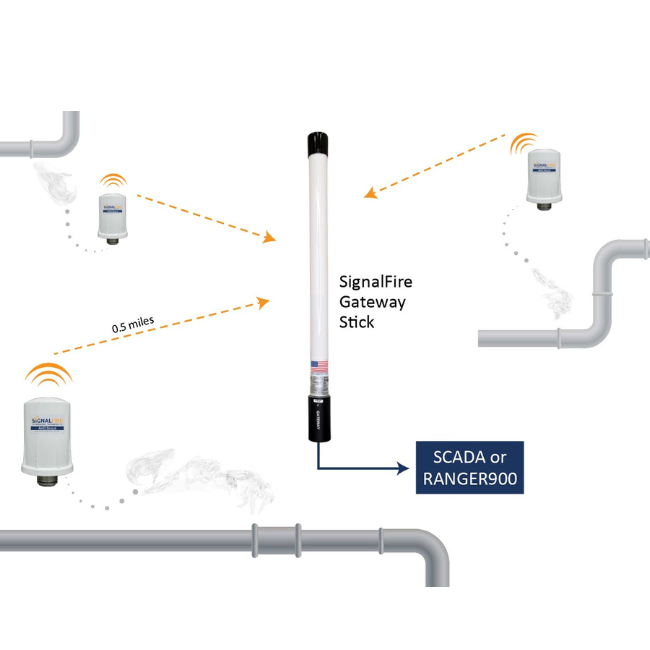
Get in Touch With Us and Tell Us About Your Toughest Monitoring and Control Challenges.
SignalFire Telemetry products connect you with crucial product and hardware data at any of your oil and gas operation sites—whether it’s a pump, pipeline, or storage tank.

SignalFire Telemetry devices install anywhere water asset monitoring is needed, whether it’s for collection purposes, treatment, or delivery.

SignalFire Telemetry devices can monitor key assets and can do it affordably, without any renovation or high-priced engineering costs. They install easily with no required cable or additional power. The data is available on your phone or computer and the cloud service can even output to your corporate system to integrate with the rest of your data and keep your operation running.

SignalFire Telemetry devices can monitor and manage water supplies and additives throughout the property, helping you avoid catastrophic shortages and keep your irrigation plan on track.

Avoid costly product loss in bulk storage tanks, terminals, and transportation movements. Whether calling for tank levels, gauge pressure, or even movement pumps or pipelines, SignalFire products can fill any monitoring gap throughout a facility.

Environmental fines for businesses are frustrating and can bring business to a standstill until they’re worked out. No business wants to hurt the environment, and in competitive markets stopping production affects the bottom line and staff. But there are effective and affordable solutions with SignalFire Telemetry devices.

Expand visibility and control of your refinery or petrochemical processing facility without expensive renovations or redesigns. And do it with your current gauges and hardware. SignalFire telemetry devices are designed to work in harsh chemical environments and meet the strictest safety and security standards

No matter the size of your service map, monitoring remote assets ensures efficiency and keeps your operation in compliance. That’s how SignalFire devices can really help, offering the most affordable and effective monitoring solution that will monitor liquid, gas, electricity, and other assets.

Explore the diverse applications of SignalFire Wireless Telemetry Systems across different industries.

Access our latest brochures to explore comprehensive information about our products and services.

Easily find the sensors that are compatible with our systems on this dedicated page.

Explore a comprehensive collection of images showcasing our products, installations, and real-world applications.

Many industrial wireless systems utilize radio modules or a standards-based protocol to support varying data communications with its network. SignalFire developed the radio network for its telemetry systems from the ground up to meet the specific needs of the “last mile” sensor data collection. In addition to providing high data reliability and long-range transmissions, the SignalFire radio network has a low power and user-friendly design providing for an overall best total cost of ownership.
In addition, the SignalFire radio network optimized the data transmission rate for sensor measurements to maximize range and reliability. In some other network radio systems, a higher data rate is utilized to accommodate high bandwidth devices such as video cameras but comes at the expense of range. The SignalFire wireless mesh network eliminates the need to compromise reliability for data range.
As a maximum number of useable bandwidths exist for any radio network, the SignalFire network approaches over-the-air throughput in terms of number of remote device readings per gateway. A single SignalFire Gateway can accommodate one message per second on average (60 packets per-minute), which is over 86,000 messages per day. This traffic amount allows adequate network bandwidth for meshing and wireless configuration including remote PACTware configuration of HART instruments.
To calculate the packets per-minute, evaluate the number of remote devices and their check-in (or reporting) interval. A calculator built into the SignalFire Toolkit software simplifies this task. To open the calculator, select the ‘Packet/Minute Calculator’ from the Tools Menu on the main toolkit window.
Begin using the calculator by entering the number of nodes configured at each check-in interval. The calculator will display the average packets per minute, which should be less than 60. The example below shows a network consisting of 65 nodes and a packet-per-minute average of 48.1, which is well under the limit.
To maximize your available network throughput, simply limit the number of remote devices that have fast check-in intervals.
When connected to a Gateway with the ToolKit software, packets-per-minute is displayed in the left-hand side of the window. This “real-time” view of the current Gateway load will quickly indicate if a Gateway is too heavily loaded.
Consider the check-in interval required for the application. Longer check-in periods reduce network traffic while extending battery life.
Limit the number of devices configured with 5 and 15 second check-in intervals.
When using Pressure Scouts (sensor nodes), consider using alarm threshold settings to limit the number of messages the unit sends in normal operation before exceeding the configured alarm threshold(s).
Using the ToolKit Packet/Minute Calculator along with best practices will ensure a reliable network under different operating conditions.
Get in Touch With Us and Tell Us About Your Toughest Monitoring and Control Challenges.





"*" indicates required fields


